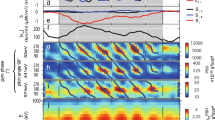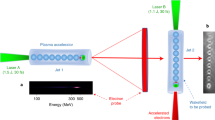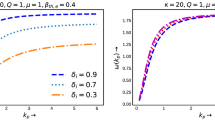Abstract
ELECTRONS in a plasma undergo collective wave-like oscillations near the plasma frequency. These plasma waves can have a range of wavelengths and hence a range of phase velocities1. Of particular note are relativistic plasma waves2,3, for which the phase velocity approaches the speed of light; the longitudinal electric field associated with such waves can be extremely large, and can be used to accelerate electrons (either injected externally or supplied by the plasma) to high energies over very short distances2á¤-4. The maximum electric field, and hence maximum acceleration rate, that can be obtained in this way is determined by the maximum amplitude of oscillation that can be supported by the plasma5á¤-8. When this limit is reached, the plasma wave is said to ᤘbreakᤙ. Here we report observations of relativistic plasma waves driven to breaking point by the Raman forward-scattering instability9,10 induced by short, high-intensity laser pulses. The onset of wave-breaking is indicated by a sudden increase in both the number and maximum energy (up to 44 MeV) of accelerated plasma electrons, as well as by the loss of coherence of laser light scattered from the plasma wave.
This is a preview of subscription content, access via your institution
Access options
Subscribe to this journal
Receive 51 print issues and online access
$199.00 per year
only $3.90 per issue
Buy this article
- Purchase on Springer Link
- Instant access to full article PDF
Prices may be subject to local taxes which are calculated during checkout
Similar content being viewed by others
References
Stix, T. H. The Theory of Plasma Waves (McGraw-Hill, New York, 1962).
Dawson, J. M. Scient. Am. 260, 54–61 (1989).
Tajima, T. & Dawson, J. M. Phys. Rev. Lett. 45, 267–270 (1979).
Joshi, C. et al. Nature 311, 525–529 (1984).
Dawson, J. M. Phys. Rev. 113, 383–387 (1959).
Coffey, T. P. Phys. Fluids 14, 1402–1406 (1971).
Akhiezer, A. I. & Polovin, R. V. Sov. Phys. JETP 3, 696–699 (1956).
Katsouleas, T. & Mori, W. B. Phys. Rev. Lett. 61, 90–93 (1988).
Forslund, D. W., Kindel, J. M. & Lindman, E. L. Phys. Fluids 18, 1002–1016 (1975).
Mori, W. B., Decker, L. D., Hinkel, D. E. & Katsouleas, T. Phys. Rev. Lett. 72, 1482–1485 (1994).
Chen, F. F. Phys. Scripta T30, 14–23 (1990).
Joshi, C., Tajima, T., Dawson, J. M., Baldis, H. A. & Ebrahim, N. A. Phys. Rev. Lett. 47, 1285–1288 (1981).
Turner, R. E. et al. Phys. Rev. Lett. 57, 1725–1728 (1986).
Batha, S. H. et al. Phys. Rev. Lett. 66, 2324–2327 (1991).
Nakajima, K. et al. Phys. Rev. Lett. 74, 4428–4431 (1995).
Coverdale, C. A. et al. Phys. Rev. Lett. 74, 4659–4662 (1995).
Everett, M. J. et al. Phys. Rev. Lett. 74, 1355–1358 (1995).
Sprangle, P., Esarey, E., Ting, A. & Joyce, G. Appl. Phys. Lett. 53, 2146–2148 (1988).
Sessler, A. M. Physics Today 41, 26–34 (1988).
Kitagawa, Y. et al. Phys. Rev. Lett. 68, 48–51 (1992).
Clayton, C. E. et al. Phys. Rev. Lett. 70, 37–40 (1993).
Everett, M. et al. Nature 368, 527–529 (1994).
Ebrahim, N. A. J. appl. Phys. 76, 7645–7647 (1994).
Decker, C. D., Mori, W. B. & Katsouleas, T. Phys. Rev. E50, R3338–R3341 (1994).
Tzeng, K-C., Mori, W. B. & Decker, C. D. Phys. Rev. Lett. (submitted).
Danson, C. N. et al. Opt. Commun. 103, 392–397 (1993).
Brückner, R. thesis, Univ. Orléans (1994).
Jackson, J. D. Classical Electrodynamics (Wiley, New York, 1975).
Fraser, J. S. & Sheffield, R. L. IEEE J. quant. Electr. 23, 1489–1496 (1987).
Author information
Authors and Affiliations
Rights and permissions
About this article
Cite this article
Modena, A., Najmudin, Z., Dangor, A. et al. Electron acceleration from the breaking of relativistic plasma waves. Nature 377, 606–608 (1995). https://doi.org/10.1038/377606a0
Received:
Accepted:
Issue Date:
DOI: https://doi.org/10.1038/377606a0
This article is cited by
-
Phase-mixing of high-frequency electrostatic oscillations in multi-component dusty plasmas
Pramana (2024)
-
Femtosecond electron microscopy of relativistic electron bunches
Light: Science & Applications (2023)
-
Efficient plasma electron accelerator driven by linearly chirped multi-10-TW laser pulses
Scientific Reports (2023)
-
Photonuclear production of nuclear isomers using bremsstrahlung induced by laser-wakefield electrons
Nuclear Science and Techniques (2023)
-
PIC Simulation of the Nonlinear Phenomena in Electrostatic Wave Breaking Regime: Magnetized Warm Plasma
Brazilian Journal of Physics (2023)
Comments
By submitting a comment you agree to abide by our Terms and Community Guidelines. If you find something abusive or that does not comply with our terms or guidelines please flag it as inappropriate.



